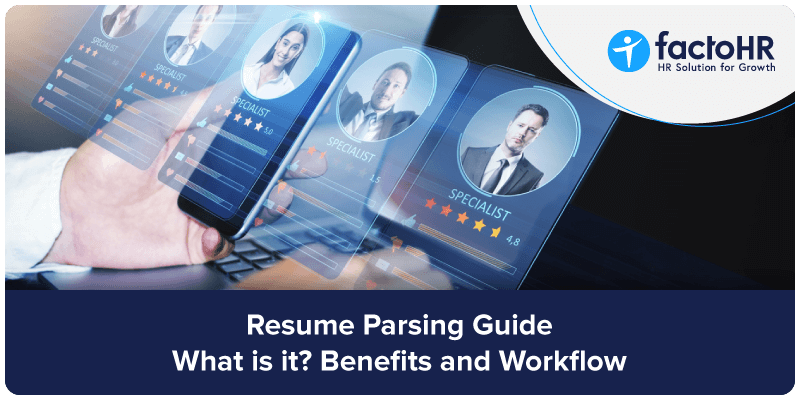Resume Parsing Guide What is it? Benefits and Workflow

Table of Contents
Hiring the right applicant is one of the vital factors for any organization’s success. However, when it comes to screening and shortlisting applicants from a large number of candidates, it can become a bit challenging and time-consuming process. In the past few years, resume parsing has emerged as a helpful tool that can improve the selection process and streamline the recruitment process.
Resume parsing offers several benefits for employers and recruiters, including improved efficiency, increased accuracy, and enhanced candidate experience. By automating the process of extracting relevant information from a candidate’s resume, recruiters and employers can significantly reduce the time and effort required to evaluate and compare candidates objectively. This enables them to focus on more critical aspects of the recruitment process, such as interviewing and selecting the best candidates.
In this article, we’ll cover everything you need to know about resume parsing, including its benefits, how it works, and some rules to follow when using it.
What is Resume Parsing?
Resume parsing is a process of extracting information such as experience, skills, knowledge, education etc, from a candidate’s resume. It involves searching for keywords, adding specific search criteria to find the most qualified candidates, and efficiently storing a large number of resumes. It is designed to get candidates’ resumes into HR’s systems.

Benefits of Resume Parsing
The biggest advantage of resume parsing is that it helps to find the best candidate for the open position. Here are some of its other benefits:
1. Time Saving
Resume parsing can help you to quickly sort resumes by automatically searching for relevant keywords and qualifications instead of manually searching each resume which takes a lot of time.
2. Increases Accuracy
Using software to sort resumes can ensure you do not miss any desired keywords in applications. While manually scanning resumes for these words and qualifications can be effective, resume parsing software can review multiple resumes and offer quick results with little chance of error.
3. Standardization
The software can help standardize the recruitment process, ensuring that all candidates are evaluated objectively and consistently. Standardization also ensures that all candidates are evaluated based on the same set of criteria, reducing the risk of bias and increasing the likelihood of finding the best fit for the jo
4. Enhances Candidate Experience
The software can help create a more positive candidate experience by providing candidates with a faster and more streamlined application process. This can help attract high-quality candidates who value efficiency and convenience.

How does Resume Parsing Work?
The resume parsing process involves using software tools to scan a candidate’s resume and extract the required information to create a detailed candidate profile. The first step of the process starts by collecting a candidate’s resume. The resumes can be collected from different sources such as recruitment agencies, company websites, or job boards.
Once the resume is collected, the resume parsing software uses Natural Language Processing (NLP) technology to identify the text and analyze specific information such as job titles, work experience, skills, and education. Then it extracts this information and creates a detailed candidate profile that can be easily sorted and filtered. This allows recruiters to quickly and efficiently evaluate candidates based on their qualifications and experience.
Rules to Follow While Parsing Resumes
While parsing resumes, there are certain rules to follow to ensure efficiency and accuracy. Here are some of the key rules to follow:
1. Use a Standardized Format
Make sure to use a standardized format for parsing resumes, so that data can be easily extracted and analyzed. It will help to get accurate and efficient information from resumes.
2. Define Data Fields
Define the specific data fields that you want to extract from each resume and prioritize them on the basis of job requirements. It will help you to focus on important information only and not get overwhelmed with other irrelevant information.
3. Use the Right Tools
Use an efficient and reliable tool that can handle different file formats, languages, and data fields. This will help you avoid errors and save time.
4. Regularly Update Parsing Algorithm
Regularly update your parsing algorithm to adapt to changes in the job markets and new resume formats. It will help you to extract the most relevant and up-to-date information from each resume.
5. Ensure Data Security
Make sure to follow all data privacy and security protocols while parsing resumes, to protect sensitive information from unauthorised access.

Conclusion
Resume parsing is an important feature to have in online recruitment software for organizations who want to improve their recruitment process. By automating the process of extracting information from candidates’ resumes, it can help you to reduce waiting time, improve accuracy, and enhance candidate experience.
Grow your business with factoHR today
Focus on the significant decision-making tasks, transfer all your common repetitive HR tasks to factoHR and see the things falling into their place.

© 2025 Copyright factoHR


